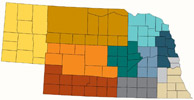Extension, Cooperative

Nebraska Cooperative Extension: Faculty and Staff Publications
Document Type
Article
Date of this Version
6-2010
Citation
Published in Journal of Animal Science, volume 88, issue 6, June 2010, pages 2153–2165; and Journal of Animal Science, volume 89, issue 9, September 2011, page 2955 [Erratum].
doi:10.2527/jas.2009-2586
doi:10.2527/jas.2011-89-9-2955
Abstract
Numerous models and indices exist that attempt to characterize the effect of environmental factors on the comfort of animals and humans. Heat and cold indices have been utilized to adjust ambient temperature (Ta) for the effects of relative humidity (RH) or wind speed (WS) or both for the purposes of obtaining a “feels-like” or apparent temperature. However, no model has been found that incorporates adjustments for RH, WS, and radiation (RAD) over conditions that encompass hot and cold environmental conditions. The objective of this study was to develop a comprehensive climate index (CCI) that has application under a wide range of environmental conditions and provides an adjustment to Ta for RH, WS, and RAD. Environmental data were compiled from 9 separate summer periods in which heat stress events occurred and from 6 different winter periods to develop and validate the CCI. The RH adjustment is derived from an exponential relationship between Ta and RH with temperature being adjusted up or down from an RH value of 30%. At 45°C, the temperature adjustment for increasing RH from 30 to 100% equals approximately 16°C, whereas at −30°C temperature adjustments due to increasing RH from 30 to 100% equal approximately −3.0°C, with greater RH values contributing to a reduced apparent temperature under cold conditions. The relationship between WS and temperature adjustments was also determined to be exponential with a logarithmic adjustment to define appropriate declines in apparent temperature as WS increases. With this index, slower WS results in the greatest change in apparent temperature per unit of WS regardless of whether hot or cold conditions exist. As WS increases, the change in apparent temperature per unit of WS becomes less. Based on existing windchill and heat indices, the effect of WS on apparent temperature is sufficiently similar to allow one equation to be utilized under hot and cold conditions. The RAD component was separated into direct solar radiation and ground surface radiation. Both of these were found to have a linear relationship with Ta. This index will be useful for further development of biological response functions, which are associated with energy exchange, and improving decision-making processes, which are weather-dependent. In addition, the defined thresholds can serve as management and environmental mitigation guidelines to protect and ensure animal comfort.
Included in
Agricultural and Resource Economics Commons, Agricultural Education Commons, Food Science Commons, Rural Sociology Commons


Comments
Copyright © 2010 American Society of Animal Science; published by Oxford University Press. Used by permission.